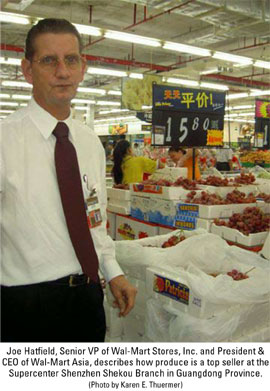 Wal-Mart Stores Inc. is well known around distribution channels for implementing lean, mean logistics schemes. In China in particular, corporate officials exclaim that with each new store it builds, the company introduces advanced technology and retailing knowledge to the local retail industry and enhances local manufacturing and logistics sectors.
Wal-Mart Stores Inc. is well known around distribution channels for implementing lean, mean logistics schemes. In China in particular, corporate officials exclaim that with each new store it builds, the company introduces advanced technology and retailing knowledge to the local retail industry and enhances local manufacturing and logistics sectors.
With China experiencing ramped up growth and manufacturing, logistics is an industry that is quickly evolving, although perhaps not to world standards as many would like. Wal-Mart works out the kinks by actively involving itself in the local Chinese communities, working with officials, and training people. The Bentonville, AK-based mega retailer needs to. Next year Wal-Mart will add another 12 new locations to the 24 Chinese cities it already serves. Those include Shenzhen, Kunming, Fuzhou, Dalian, Xiamen, Shantou, Dongguan, Harbin, Changchun, Shenyang, Changsha, Beijing, Nanchang, Ji'nan, Qingdao, Tianjin, Nanjing, Nanning, Wuhan, Guiyang and Taiyuan.
"In the United States the growth opportunities are limited," admits Joe Hatfield, Senior Vice President of Wal-Mart Stores, Inc. and President and CEO of Wal-Mart Asia. But in China, with 1.3 billion people and an eight percent Gross Domestic Product (GDP), the business potential appears unlimited.
While touring this AJOT reporter through Wal-Mart's Supercenter Shenzhen Shekou Branch in Guangdong Province in September, Hatfield offers some insight to Wal-Mart's success in China. The retailer has been in China since 1996 when it opened its first Supercenter in Luohu District, Shenzhen. Now its operation includes 40 Supercenters, three SAM'S CLUBS, and two Neighborhood Markets.
To put it succinctly, Wal-Mart knows exactly what it is doing. The company emphasizes an "Every Day Low Prices" philosophy and maintains low-price structure through aggressive buying and smart distribution. Wal-Mart makes the concept work well in China. The company has already invested up to RMB1.6 billion in China and paid more than RMB1.4 billion in taxes. Wal-mart's Supercenter in Nanjing, which opened in January 2004, does some 180,000 transactions per week with over half a million people entering the store.
"That's 70,000 people a day," Hatfield exclaims.
Local procurement
Given the huge volume of goods that Wal-Mart sells in China, its buyers are critical to the company's success. Unlike in the United States, buyers are needed in each city where it operates, primarily because of distributor agreements.
"Plus, 90% of the market is local brands," Hatfield explains. "For example, every city has their own local beer and tobacco. There are very few national brands. Very little crosses the provincial boundaries."
One of the reasons are the Chinese people's vastly different preferences and tastes from region to region, even city to city. Hatfield uses cooking oil as a good example.
"For decades the women have cooked with a particular oil from their province, be it peanut oil or corn oil," he says. "That is what they are used to using. You go to Szechuan Province and the flavors are hot and spicy. You go to Hunan Province, and there it is also hot and spicy, but in a different way from Szechuan. Shanghai food is also significantly different from what it is here in Shenzhen. To satisfy everyone, we have to have what the customer base prefers. It is very difficult to get people to switch."
With all of the manufacturing that is taking place in China today, it comes as no surprise that Wal-Mart imports very little into China.
"Many of the goods we are carrying are manufactured in China," Hatfield says. "Villages have historically always been self sufficient."
Yet Hatfield points out that the Chinese are getting more brand sensitive. "But only for products at the higher end," he says. For example, one SAM'S CLUB recently sold three $25,000-priced L









